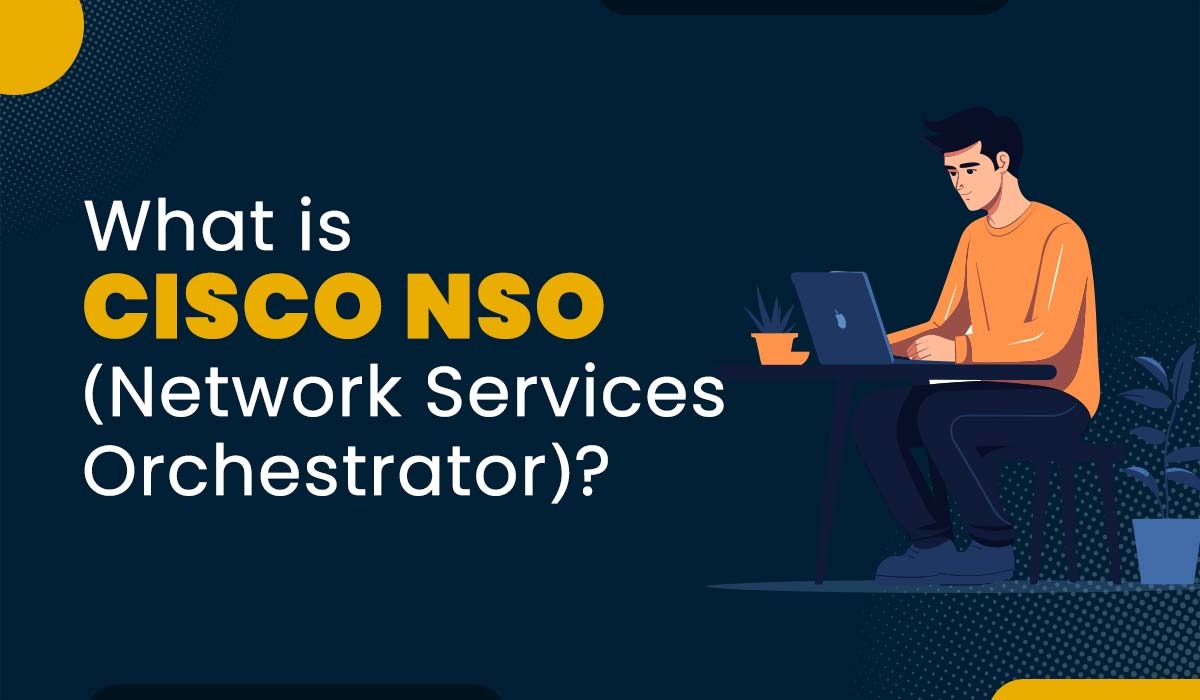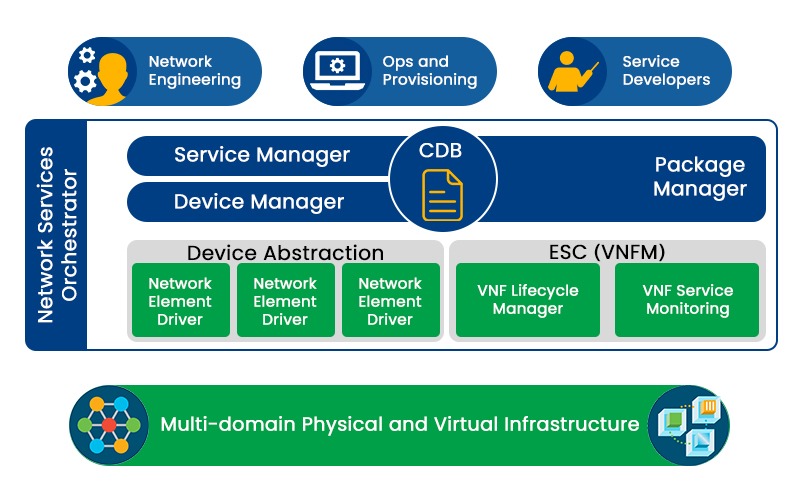What is Cisco NSO (Network Services Orchestrator)?

As time advances, networks become more complex, and traditional manual ways of managing them are no longer good enough. Organizations need to have streamlined network management solutions in order to run networks smoothly. Cisco NSO emerges as a game-changer, offering automation and orchestration capabilities that enable organizations to adapt, scale, and innovate with agility. By automating repetitive tasks and simplifying complex workflows, it gives the freedom to businesses to enhance operational efficiency, reduce errors, and, most importantly, accelerate service delivery. Empower your network automation journey with Cisco NSO training. In this blog, we will discuss the Cisco network services orchestrator (NSO) use cases in detail, along with its download and installation. We will also explain different network service orchestration tools and look into the basic Cisco NSO vs Ansible. Before getting into more details, let’s first understand what Cisco NSO really is. Cisco NSO or Network Services Orchestrator is a powerful tool developed by Cisco Systems and mainly designed to automate the deployment, configuration, and management of network services across multi-vendor and multi-technology environments. Moreover, it acts as a centralized orchestrator that mainly abstracts the complexity of the underlying network devices and technologies. This allows network administrators to define as well as deploy services through a single interface. By using a model-driven approach, Cisco NSO makes it possible to ensure consistency as well as accuracy in network configurations. Further, this will help in reducing human errors and any misconfigurations. NSO is used by various organizations irrespective of size. Some of these are: Now, many are curious about how Cisco NSO works. Let’s understand the working in detail. NSO takes a model-driven approach, defining and managing network services via a graphical interface or code. This model-based approach allows: Services may be created and delivered rapidly and consistently, avoiding human configuration problems. Network administrators may administer all services from a single point of management, which increases operational efficiency. NSO gives a comprehensive picture of the network and allows for fine-grained control over service behavior. Let’s now understand some of the benefits associated with Cisco NSO. Below, we have explained the different benefits that Cisco NSO can offer. The Cisco NSO architecture is like a central hub that helps manage and automate network services. It consists of several key components that work together to make this happen. Note: Cisco NSO architecture is like a smart system that keeps track of network configurations, talks to network devices, manages virtual functions, and makes sure everything is working as it should be. In order to get started with Cisco NSO, one must first download the software from the official Cisco website. To download, simply visit the Cisco website download section or click on the given link, i.e., https://developer.cisco.com/site/nso/. Now, select the appropriate version based on your requirements and follow the installation instructions. Note: Cisco NSO only supports either Linux systems or macOS. If someone is using a window, it is not possible to install it natively on their systems. One can install NSO either on a Linux virtual machine or in a container. If someone is using a docker, there are options for them to install pre-built system images. After downloading the Cisco NSO image file, it’s time to install it on a system. The installation process is straightforward and well-documented. We have provided step-by-step instructions in order to help individuals in setting up the platform quickly and efficiently. The installation process generally involves setting up the necessary infrastructure, configuring the software components, and integrating Cisco NSO with the existing network environment. Let’s now understand the Cisco NSO use cases. Cisco NSO offers a wide range of use cases across various industries and network environments. Some common use cases include: Automating the provisioning and deployment of network services such as VPNs, firewalls, and load balancers. Managing and maintaining network device configurations in a consistent and scalable manner. Streamlining repetitive tasks and workflows to improve operational efficiency and reduce manual errors. Integrating and orchestrating services across heterogeneous network environments with different vendor devices. Empowering end-users to request and provision network services through self-service portals, enhancing agility and responsiveness. We now have a good knowledge of Cisco NSO, let’s discuss some of the most famous Network service orchestration tools. Network service orchestration tools are a kind of software program that helps in automating the provision, configuration, and management of network services. These tools assist in streamlining complex network operations, reduce manual errors, and enhance overall network efficiency. Further, Network service orchestration can be classified into 3 categories. These are: Now, some of the most popular Network service orchestration tools are: Cisco NSO: It simplifies network management through automating as well as orchestrating network services. In order to allow efficient delivery and reduce manual configuration errors, it offers a single point of control for all network devices. Ansible: Ansible is one of the most powerful automation tools for various IT tasks, which include configuration management, application deployment, and orchestration. It makes use of simple YAML scripts to define tasks. With Ansible, it is easy to automate complex workflows and streamline IT operations. VMware NSX: It is a software-defined networking solution that virtualizes network services. This allows organizations to create secure, agile, and scalable networks. It also helps in providing network virtualization and security features. With VMware NSX, organizations can easily improve network performance as well as simplify their network management. HPE Intelligent Management Center (IMC): It is a network management platform that offers end-to-end visibility as well as control over network infrastructure. There are various other features that are offered by HPE (IMC), such as network monitoring, configuration management, and performance optimization, that help many organizations to efficiently manage their network resources. Puppet: Puppet is a configuration management tool that automates the deployment and management of IT infrastructure. It uses declarative language to define system configurations, ensuring consistency across servers and reducing manual intervention. Puppet helps organizations streamline their IT operations and improve infrastructure reliability. There are many other tools apart from the ones that we defined above, such as Juniper Contrail, OpenStack, SaltStack, VMware vRealize Automation, etc. To get more information about the tools, one can go through the Network service orchestration tools. Now moving on to the next section, where we will be discussing the difference between the two most used network orchestration tools, i.e., Cisco NSO and Ansible. While both Cisco NSO and Ansible are popular automation tools in the networking industry, they serve different purposes and have distinct use cases. We have explained some of the basic differences between the two in a tabular form based on different factors. Cisco NSO (Network Services Orchestrator) is a software platform by Cisco that is mainly used to automate as well as orchestrate network services. It allows efficient management and provisioning of network resources in a scalable manner. Yes, Cisco NSO is available to download from DevNet, but only for non-production use. Although the terms of the download are outlined under a click-to-accept license, in simple terms, anybody can use it whatever they choose as long as it is not being used for production purposes. A Network Orchestration Tool is a software platform used to automate and streamline the management of network resources, configurations, and services dynamically and efficiently. Some of the examples of NSO tools are Cisco NSO, Ansible, etc. Yang modeling language is used in the Cisco network services Orchestrator NSO. Cisco NSO is a network service orchestration tool that allows organizations to automate as well as streamline their network operations. In this blog, we have explained the Cisco network services orchestrator along with its functioning and benefits. We also have covered its use cases and different types of network services orchestrator tools. We also have compared the basic differences between Cisco NSO and Ansible for better understanding.Introduction
What is Cisco NSO?
How Does Cisco NSO work?
Benefits of Cisco NSO
Cisco NSO Architecture

Cisco NSO Download & Installation
Cisco NSO Use Cases
Service Orchestration
Configuration Management
Network Automation
Multi-Vendor Support
Self-Service Portals
Network Service Orchestration Tools
Cisco NSO vs Ansible
Factor Cisco NSO Ansible Vendor Cisco Systems Red Hat Primary Use Network automation and orchestration IT automation and configuration management Language YANG modeling language YAML (Yet Another Markup Language) Complexity Suitable for complex network environments Simple and easy to use for general automation tasks Scalability Highly scalable for large networks Scalable for managing multiple devices and configurations Integration Integrates well with Cisco devices and other vendors Integrates with a wide range of devices, platforms, and tools Community Support Strong community support and documentation Large and active community with extensive resources Learning Curve Steeper learning curve due to network-specific concepts Relatively easier to learn and use for general automation tasks Commercial Support Available through Cisco Available through Red Hat and other vendors State Management Built-in state management capabilities Limited state management features Use Cases Ideal for service providers and large enterprise networks Suitable for IT operations, cloud provisioning, and application deployment Execution Mode Agent-based architecture for network devices Agentless architecture for managing remote systems Cost Typically higher costs due to enterprise-level features Generally lower cost with the open-source version available Frequently Asked Questions
Q1. What is Cisco NSO?
Q2. Is Cisco NSO free?
Q3. What is NSO tool?
Q4. Which language is used in the Cisco network services Orchestrator NSO?
Conclusion







